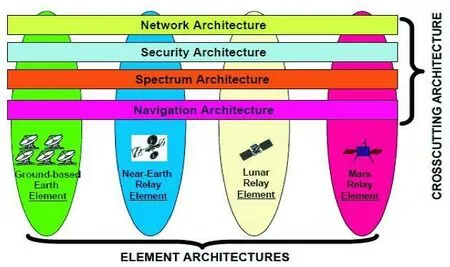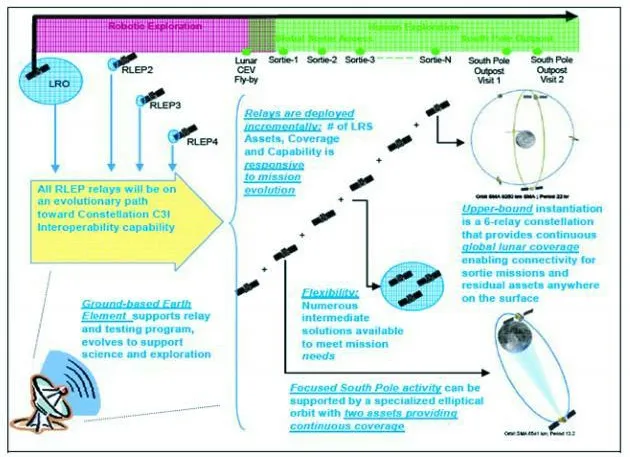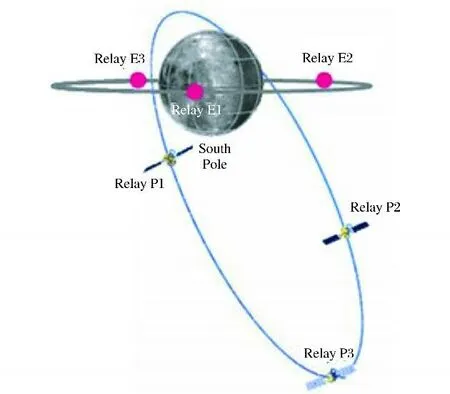用于深空探测任务的先进通信与导航体制
2011-01-08冯礼和平劲松
冯礼和 平劲松
(中国科学院上海天文台,上海 200030)
1 Introduction
This paper is mainly based on a report submitted by NASA's Space Communication A rchitecture Working G roup (SCAWG), which provides space communication &navigation (C&N)architecture recommendations for 2005 -2030.The architecture is composed of four physical elements with overlapping network, security , RF spectrum, and navigation architectures(Fig.1).
The top-level space C&N architecture w ill provide the necessary end-to-end data communication and navigation services to support science and exploration user spacecraft operating anywhere in the solar system——in the earth vicinity , lunar vicinity, Mars vicinity, and other regions (Fig.2).In the rest of this paper, we focus on the keyfeatures of the Lunar and Mars Relay Elements.

Fig.1 C&N consisting of element and cross-cutting architectures

Fig.2 Space communication architecture~2030:A network of networks
2 Lunar relay element
To fully understand the architecture of the lunar relay(LR)element, we must bear in mind that NASA's current lunar exploration strategy , which is aimed at sending astronauts back to the Moon before 2018, is highly complex and alw ays evolving.Hence the LR element architecture allow s flexible implementation to accommodate future changes in lunar exploration strategy, and response to the exploration and science requirements that are still evolving within NASA[1].
First, the lunar space segment primarily provides two-w ay connectivity with Earth, and navigation tools for space-based and lunar surface users.Secondly, the lunar surface segment provides two-w ay connectivity and navigation aids to users in the vicinity of the lunar outpost by w ay of the lunar communications terminal(LCT), which provides wide area network (WAN)service and acts as an access point to the lunar relay satellite(LRS), and navigation beacons.Lastly, the supporting Earth round segment provides two-w ay space/ground connectivity with the LRS by means of the ground-based Earth element(GEE), and accommodates all user-service data and relay-satellite command/control with the LR M ission Operations Center (LM OC)[1].Fig.3 presents evolving LR element implementation concepts.
The architecture of the LR element is more difficult to optimize than, for example, that of the Mars relay element.For extensive operation over long periods of time, and for better coverage of the lunar surface, orbiting LR satellites must stay in high-altitude orbits in order to minimize gravitational non-uniformity caused by mascons that may necessitate undesirable frequent adjustments of the orbits.However, simple solutions such as putting three satellites 120 degrees apart into the same high orbit, of which two w ould alw ays be above the lunar horizon to support line-of-sight relay communication, are not w orkable.
It can be shown that circular orbits around the Moon above 1 200 km are unstable.At such altitudes, revolving satellites are not only under the influence of the Moon, but also constantly subject to the substantial gravitational pull of the massive Earth that is about 400 000 km aw ay.These nonnegligible forces can actually change the shape of an orbit from a circle to an elongated ellipse.As the eccentricity of the orbit gets increasingly large,the satellite w ould either crash into the lunar surface or fly away from the Moon altogether in a hyperbolic orbit. Depending on the specific orbit,such eventuality can happen“within tens of days”.Although stable circular lunar orbits do exist below an inclination of 39.6°, satellites in these orbits spend so much time near the equator that they are really unsuitable for lunar relay applications in which the poles must be continuously covered[2].
In future exploration of the Moon, NASA w ill mainly focus on the polar regions for many reasons.Being alw ays hidden from the Sun, deep polar craters may contain ice that astronauts could unearth.The ice could then be turned into drinking water, or split into hydrogen and oxygen for rocket fuel and other uses.Hence these astronauts w ant to maintain unblocked communication links with the Earth via lunar relay satellites that w ould provide constant coverage of the strategically important polar regions.

Fig.3 Evolving lunar relay element implementation concepts
Jet Propulsion Laboratory (JPL)and some NASA space centers have investigated this problem in depth for many years since the first man landed on the Moon, and they have discovered a new class of stable high-altitude lunar orbits[3-5].T.Ely of JPL recommends spacing three LR satellites 120°apart in the same elliptical(eccentricity 0.6)orbit at an inclination of 51°, with the periapsis and apoapsis being approximately 700 and 8 000 km above the north and south lunar poles respectively(see Fig.4).The satellites revolve at much higher speeds past the much closer north pole, w hile they spend about 8 out of the 12-hour period moving slow ly over the south pole.Tw o of the three satellites in this configuration w ould alw ays be in radio line-of-sight from a south pole moonbase.While these highly-inclined, highly elliptical orbits are not only the most stable for LR satellites in C&N applications, but also the cheapest satellite configuration to put into operation[2].
NASA proposed two different approaches[1]to satellite constellation designs for lunar communication and navigation.The first is based on the argument that“if one could save on the number of satellites, it might make sense to bias the coverage tow ards the hemisphere in which the coverage zone lies and sacrifice some coverage in the opposite hemisphere.” Since NASA w ants to focus on the lunar south pole, it is natural to bias the coverage tow ards the southern hemisphere, with a two-satellite polar configuration (similar to the one described in the previous paragraph)combined with three additional satellites evenly spaced in a circular equatorial orbit. This five-satellite configuration (also called“Cover Where You Go” constellation), similar to the one shown in Fig.4, provides continuous coverage of the lunar surface with the exception of the upper part of the northern lunar hemisphere.Furthermore,[2]it is pointed out that in this configuration, if we w ish to switch the orbit to cover the opposite pole (hemisphere), the satellites could be easily repositioned within the orbit.
In the other NASA approach aiming at providing the greatest flexibility with a more robust constellation design, configurations with two polar orbital planes of identical size each having 3(or 4)satellites for a total of 6 (or 8)satellites are proposed.It is claimed that continuous, 100%lunar global coverage can be achieved with just six satellites, although better coverage with redundancy for enhanced reliability can be achieved with eight.
Ref.[1]lists fifty specific orbit cases representing classes of lunar relay orbits studied in detail by NASA, with a total of 2 to 12 satellites distributed in 1~4 orbital planes.In the category of south pole partial coverage, NASA also analyzed configurations of LR satellites revolving in halo orbits at the Earth-Moon L1/L2/L4/L5 Lagrangian equilibrium points. In the restricted three-body problem in astronomy——the most famous being the Sun-Jupiter-asteroids ensemble——where a small body revolves around a much more massive one, there are two unstable equilibrium points L1/L2 lying very close to and on opposite sides of the small body along the line connecting the two bodies[6].It can be shown that stable circular haloorbits exist in which very small objects (such as satellites)can revolve in a plane perpendicular to the above-mentioned imaginary line.Since the orbits at L1/L2 have relatively large radii (assumed to be 38 000~68 000 km by NASA)compared to the Moon radius (about 1 738 km), if several evenly spaced satellites are moving in these orbits,there is alw ays one satellite that can be seen above the horizon from a south pole moonbase (see Fig.5).Hence the L1/L2 halo orbits are considered as two of the seven legitimate classes of LR satellites orbits in the SCAWG report.

Fig.4 A six-satellite.“polar+equatorial” hybrid configuration for the LR element recommended by NASA.The polar and equatorial satellites are labeled Pn and En respectively
NASA also studied halo orbits at two other stable equilibrium points L4/L5 lying ±60°from the small body , but they are not included for further consideration with no details provided.Lastly, NASA analyzed the inclined circular and polar circular classes with high-altitude orbits among the 50 listed orbits, despite the fact that such circular high orbits are generally unstable.
3 Mars relay element

Fig.5 A five-satellite L2 halo orbit (assumed radius:42 000 km).configuration show s that at the extreme end of the orbit, an LR satellite is about 34°above horizon when observed at a sount pole moonbase L1 halo orbits are similar to the present case.although distances for the LR satellites in L1 halo orbits to the Earth are smaller
The Mars relay(M R)element is an evolving set of relay spacecraft in orbit at Mars.It provides relay telecommunications, navigation, and timing services to user spacecraft in the vicinity of Mars.Users supported include those on the Martian surface, in the Mars atmosphere, in Mars orbit, or on approach to Mars.As shown in Fig.6, M R satellites provide access links to users on or near Mars,and also establish trunk link line communications to ground-based Earth element.A user spacecraft and an Earth station can carry out store-and-forw ard command and telemetry services via this trunk link line.Furthermore, two or more user spacecraft may communicate among themselves though an M R element.

Fig.6 Mars relay element overview
Before the advent of the proposed M R element, conventional direct-to-Earth/direct-from-Earth(DTE/DFE)link services had many drawbacks.Since DTE/DFE communication was conducted over extremely long Earth-Mars distance of up to 400 million kilometers, the Mars-based telecommunication hardw are must be able to provide the required power, and so the mass and volume of the total system (including a large antenna)could be quite prohibitive.The operational cost and complexity could also be huge, as the antenna must alw ays be pointing accurately to the Earth.
The new M R approach shifts most of the burden mentioned above from the landers, rovers and other smaller and lighter users on Mars to the Mars Relay satellites that have to become a lot bigger, heavier and much more complex.The user spacecraft only has to communicate with the M R Element over very short distances.The M R can also offer telecommunication services w hen the Earth is out of view.Significant advantages offered by M R over DTE/DFE w ould enable and greatly enhance Mars exploration activities.
Satellite configurations recommended by NASA for the M R element seem to be relatively simple w hen compared with the LR element, as in this case a M R satellite is not affected by any nearby massive body that could make high-altitude orbits unstable, and the equivalent of the Earth-Moon L1/L2 halo orbits do not exist to harbor relay satellites.Instead, two longitudinally-offset relay satellites in an aerostationary orbit (radius:20 427 km)——the Mars equivalent of a geostationary orbit where the periods of rotation of the satellite and the planet are equal——w ould provide both communication and navigation capabilities.This minimal configuration w ill certainly not fully cover the surface of Mars, nor cover the regions far aw ay from the Mars equator.However, this simple constellation w ould probably suffice, but considering activities on Mars are usually restricted to regions near the equator, and would not be as frequent as those expected for the Moon ten to twenty years dow n the road.
This mode of C&N operations is intended for fixed or slow ly mobile users (such as landers and rovers on the surface of Mars)without any high dynamics.Ranging data w ould be provided by the two aerostationary satellites in the form of a pseudorandom code through a two-w ay communication channel.To facilitate real-time precise position determination, it is desirable to have a database of terrain elevations, ideally coupled with timing data using an USO or a cesium/rubidium atomic clock[1].
The above scenario of overlaying a constellation of dedicated relay satellites in an aerostationary orbit is considered as Phase 2 of a two-phase NASA plan, which w ould materialize probably in the decade prior to the first human mission to Mars.Initial elements of the M R in the preceding Phase 1 are hybrid science/relay orbiters that must satisfy both the mission's ow n science objectives and the provision of relay services to other Mars missions.NASA believes this approach provides an extremely cost-efficient means to establish relay infrastructure[1].Fig. 7 show s how the NASA plan w ill evolve in response to the evolving needs of exploration users, with M GS (Mars G lobal Surveyor 1997), ODY (Mars Odyssey 2001), M RO(Mars Reconnaissance O rbiter 2006), M STO(Mars Science and Telecommunications Orbiter 2011 -2013)and other future missions playing their important roles one after another, before the Mars aerostationary relay satellites w ould eventually take over.

Fig.7 Mars relay element evolving strategy
4 Extremely long baseline interferometry spacecraft tracking system located at the Earth-Moon L4/L5 Lagrangian points
For deep-space missions, Very Long Baseline Interferometry (VLBI)techniques are usually employed to track spacecraft with extremely high precision[7-8].To avoid serious adverse effects of the Earth's troposphere and ionosphere on the received radio signals, it is desirable to put the receiving antennas and processing hardw are into space.The Japanese VSOP satellite is mankind's first successful space-V LBI project;however, it is mainly intended for astronomical applications and so has never been actual used in tracking spacecraft.
Here we propose two alternatives.The first one (see Fig.8)puts the tracking hardw are and receiving antennas on C&N satellites revolving in the Earth-Moon L3/L4/L5 halo orbits, with an extremely long baseline of~600 000 km.The second one (see Fig.9)puts the tracking hardw are and receiving antennas on three evenly spaced C&N satellites in a geosynchronous orbit, with a shorter long baseline of~45 000 km.Since the resolution power of a V LBI/ELBI system is inversely proportion to its baseline length, these extremely long baselines w ould result in much better performances than those available with groundbased baselines of several thousands of kilometers.

Fig.8 Space-based ELBI configuration with tarcking stations on C&N satellites located at Earth-Moon L3/L4/L5 Lagrangian equilibrium points.

Fig.9 Space-based ELBI configuration with tarcking stations on C&N satellites evenly spaced in a geosynchronous orbit.
[1]NASA.NASA space communication and navigation architecture recommendations for 2005 -2030[R].Final Report, by the Space Communication Architecture Working Group(SCAWG), May 15, 2006
[2]NASA.A new paradigm for lunar orbits[EB/OL].Science@NASA.(2006-11-30).http://science.nasa.gov/headlines/y2006/30nov_highorbit.htm
[3]Ely T A.Stable constellations of f rozen elliptical inclined lunar orbits[J].J.Ast ronautical Sciences, 2005,53(3):302-316
[4]Ely T A, Lieb E.Constellations of elliptical inclined lunar orbits proving polar and global coverage[C]//AAS/AIAA Astrodynamics Specialist Conference. Lake Tahoe, CA, August, 2005, Paper AAS 05-343
[5]Folta D, Guinn D. Lunar f rozen orbits[C]//AIAA/AAS Astrodynamics Specialist Conference, Keystone,CO, August, 2006, Paper AIAA 2006-6479.C. J.Kaufman, Rocky Mountain Research Lab., Boulder,CO, private communication, May 1995
[6]Murray C D, Dermott S F.Solar system dynamics[M].British:Cambridge University Press, New York, NY,1999
[7]Thorton C L, Border J S.Radiometric tracking techniques for deep space navigation[M].New York:John Wiley &Sons, Inc., 2003
[8]Moyer T D.Formulation for observed and computed values of deep space network data types for navigation[M].New York:John Wiley &Sons, Inc., 2003
